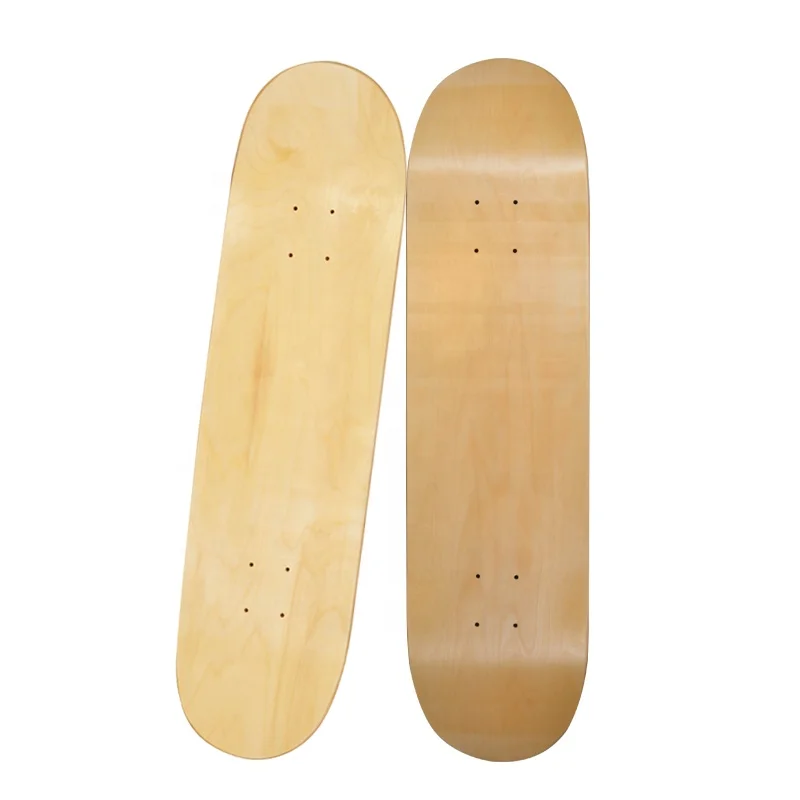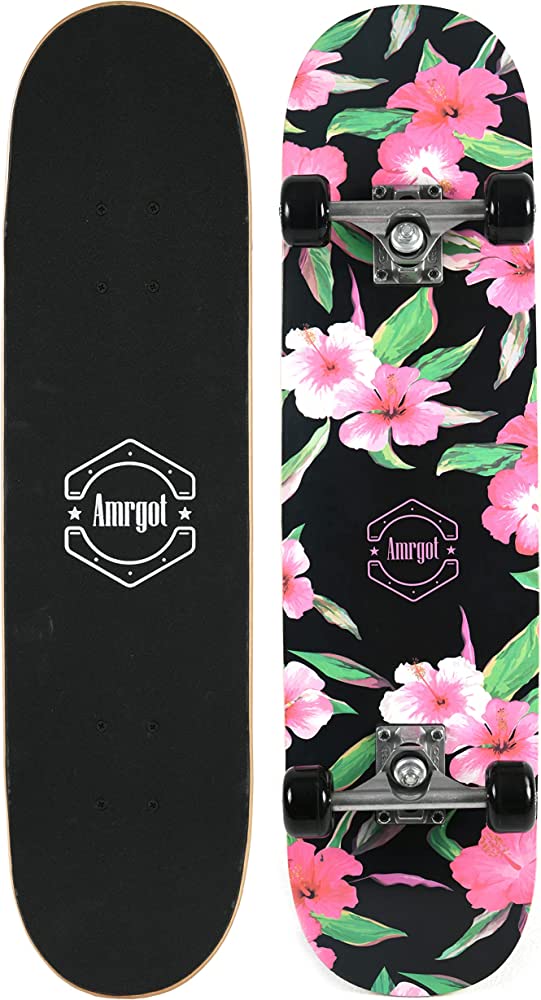Skateboard deck concave refers to the curve or arching shape of the board. It affects the skateboard’s stability, turning ability, and overall performance.
The importance of skateboard deck concave cannot be overstated. It is a crucial factor in determining the skateboard’s handling and maneuverability. Essentially, concave is the arching shape of the board that curves upward along its lengthwise axis. The depth and shape of the concave influence how the board feels and responds underfoot. A deeper concave provides more grip and control, making it suitable for performing tricks and making sharper turns. Meanwhile, a shallower concave gives a looser feel, making it ideal for cruising and carving. Skateboard deck concave comes in different variations, including radial, progressive, and w-concave designs. Understanding the type of concave that works best for your riding style can help enhance your skateboarding experience.

Credit: www.alibaba.com
The Mathematics Behind Skateboard Deck Concave
Skateboarding has always been a fascinating sport, and the skateboard deck concave plays a vital role in shaping a skateboard’s performance. It decides how a board should be ridden and eventually propelled into the air. But have you ever wondered how skateboard manufacturers manage to create concave?
There’s a significant amount of mathematics at play here.
Biomechanics And Physics
In simple words, concave is the depth and roundness of the skateboard deck’s center. An optimal concave design creates a pocket that accommodates your feet, ensuring maximum grip and control. While designing a concave, manufacturers consider both biomechanics and physics.
Biomechanics covers the body’s movement, whereas physics covers the physical properties of the deck.
Relationship Between Concave And Skateboarding Performance
Concave plays a pivotal role in any skateboarder’s performance. The right concave design improves grip, balance, and control; hence, it’s crucial to have a board that meets your riding style.
- How you distribute weight on the board
- The way you turn and lean
- The pop and rebound of the board
- The board’s overall stiff or flexible feel
Role Of Concave In Tricks And Stunts
Skateboarding is an adventurous sport that requires various tricks and stunts, and concave plays a decisive role in performing them. The shape of concave determines how easily a skateboard can flip or spin.
Ollies And Kickflips
- A steep concave provides a better pop for ollies, allowing you to jump higher and extend hang time.
- For kickflips, a more mellow concave makes it easier to flick the board.
Rails And Grinds
- A flat concave provides a wider surface for rail tricks, which is great for rails and slides.
- A deep concave can prevent the wheels from grinding, so a mellow to medium concave is preferable.
Manuals And Nose Mannys
- A perfect u-shaped concave makes it easier to balance strong on the nose or tail and maintain manuals and nose mannys.
Concave has a considerable impact on a skateboard’s performance and is an essential factor to consider when choosing a board. Manufacturers use mathematical formulae based on biomechanics and physics to design concave shapes that improve skateboarders’ overall performance. Understanding the mathematics behind concave can give you a better understanding of how your board operates and can help you choose the perfect one for your riding style.
Different Types Of Skateboard Deck Concave
Skateboard deck concave is a crucial feature of your skateboard, impacting your deck’s performance and the way you ride. Concave refers to the downward curve shape of a skateboard deck. Different types of skateboard deck concave affect your grip on the board, making different tricks possible.
Here are the key points for the different types of skateboard deck concave.
Progressive Concave
- Progressive concave is a common type of skateboard deck concave that starts with a mellow curve at the nose and tail and expands towards the center of the board.
- This type of concave shape provides excellent stability, making it easier to control your skateboard and land tricks.
- Progressive concave is ideal for beginners as it enhances the rider’s foot placement on the board, providing an easier time to execute tricks.
- Skaters who enjoy cruising, carving, or performing flip tricks may benefit from a progressive concave board.
W-Concave
- W-concave features a more pronounced, architectural concave in the center of the board, shaped like a “w”.
- This distinct concave shape provides maximum grip, allowing the rider to have their feet firmly placed on the board while carving or doing technical tricks.
- W-concave decks are ideal for experienced riders, and skaters who want to perform technical sliding tricks.
- This type of concave shape gives a unique feel to the board, making it easier to put weight on the edge of the skateboard.
Flat Concave
- As the name suggests, a flat concave deck has a flat shape with no curve.
- This type of deck is ideal for skaters who want more control and stability, as it allows maximum surface area for placing your feet.
- Flat concave decks do not provide any concavity, making it difficult to flip the board or perform technical tricks.
- This type of concave shape is mostly used by beginners who want to learn basic tricks before progressing to more technical moves.
Convex Concave
- Convex concave, better known as a “mellow” concave, features a slight upward curve towards the board’s edges.
- This type of concave shape makes it easier for riders to execute flip tricks as it elevates the skateboard’s edges.
- Convex concave decks are recommended for riders who enjoy flip tricks, cruising, and pool skating.
- This type of concave shape provides a relaxed feeling, making it easier to do technical moves.
Understanding the different types of skateboard deck concave can help you choose the best board for your riding style. Progressive concave is ideal for beginners, w-concave for experienced riders who want maximum grip, flat concave for those who want more control and stability, and convex concave for trick-oriented boarders.
Choose your board wisely and enjoy your ride!
What are MELLOW CONCAVE SKATEBOARDS good for?
Factors To Consider When Choosing Skateboard Deck Concave
Skateboard Deck Concave
When it comes to choosing a skateboard deck, there are several factors to consider. One critical factor that greatly impacts a rider’s performance is the skateboard deck concave. The degree of concave affects the deck’s strength, flexibility, and overall feel.
In this article, we will look at the factors to consider when choosing skateboard deck concave, including the rider’s style, rider’s skill level, skateboarding terrain/environment, and deck shape.
Rider’S Style
The rider’s style is an essential factor to consider when selecting concave skateboards. The concave style that suits a rider’s style ensures a comfortable and confident skateboarding experience.
- Radial concave: this type of deck features a consistent curve across the deck’s width, providing a comfortable grip that works best for cruising and carving.
- Progressive concave: this concave variation includes a steep curve to enhance response, allowing you to perform tricks and flip the board more comfortably.
Rider’S Skill Level
The level of skateboarding experience determines the suitable concave for a skateboard deck. Skaters with varying skills need different levels of concave for optimal performance.
- Mild concave: this concave type is suitable for beginners as it offers a less aggressive grip that makes it easy to control the board.
- Medium concave: this concave type is for intermediate skateboarders as it provides more control and feels comfortable when combined with flip tricks.
- Deep concave: this concave type is for advanced skateboarders as it provides maximum control, allowing the skater to perform intricate and complex tricks.
Skateboarding Terrain/Environment
The type of terrain you ride on is a crucial factor that determines the skateboard deck concave. Concave affects how your board feels, responds, and performs on different terrains.
- Low concave: this type of concave is suitable for cruising and riding on flat terrain, providing a comfortable grip.
- Medium concave: this concave type is for park and ramp skateboarding and provides a balance of grip and control.
- Deep concave: this concave type is for street skating on rough and uneven surfaces, providing maximum grip and control.
Deck Shape
The board’s shape affects the type of concave that works best. The size and shape of a deck determine its suitability for different riding styles and terrains.
- Full shape: provides a stable base, making it ideal for street and pool skating.
- Popsicle shape: allows for a lighter, versatile, and more responsive ride, suitable for skateparks and street skating.
- Old school shape: designed for pools and ramps, providing a stable and comfortable ride.
Selecting the right skateboard deck concave is vital to improve your skateboarding performance and experience. Consider your style, skill level, terrain, and deck shape to choose a perfect concave skateboard deck.
Maintenance And Care For Skateboard Deck Concave
If you are an avid skateboarder, you know how important it is to take care of your skateboard. One component that should be given extra attention is the skateboard deck concave. The concave is the curve that runs along the sides of the deck, providing you with grip and control.
Proper maintenance of the concave not only prolongs the lifespan of the skateboard, but also ensures safety while riding. Here are some tips on how to maintain and care for your skateboard deck concave.
How To Maintain The Concave
The skateboard deck concave requires special attention and maintenance to maintain its shape and effectiveness.
- Avoid putting the skateboard on its deck directly on the ground or surface, as it can cause the concave to lose its shape over time. Always store it horizontally, keeping the concave’s shape intact.
- Tighten the trucks regularly to ensure the concave is not subjected to extra pressure and flattening.
- Avoid exposing your skateboard to extreme temperatures as it can cause the concave to warp or crack.
How To Clean The Concave
Keeping the concave clean is essential for both the board’s functionality and aesthetics. Dirt and grime can accumulate inside the concave, reducing grip.
- Use a soft, damp cloth to wipe the concave clean. For stubborn dirt or grime, use a toothbrush or soft-bristled brush to scrub gently.
- Use grip tape cleaner to remove dirt and grime from the grip tape on the skateboard deck’s top side.
Best Practices For Prolonging The Lifespan Of Concave
While taking care of the concave is important, there are other measures you can take to extend its lifespan.
- Avoid exposing your skateboard to rain or moisture, which can cause the deck to warp or weaken the concave.
- Avoid exposing the skateboard to the sun or extreme temperatures, which can cause the deck to peel or crack, ultimately affecting the concave.
- Lastly, regularly check the condition of your skateboard deck, trucks, and wheels to prolong its lifespan and to ensure your safety while riding.
By following these tips, you can keep your skateboard deck concave in excellent condition, prolonging the lifespan of your skateboard and enhancing your overall skateboarding experience.
Conclusion
Finally, understanding the concave of a skateboard deck is crucial for optimizing your performance as a skateboarder. Whether you prefer a deep or shallow concave, knowing which shape works best for your individual style and preferences is essential. Additionally, being aware of the different types of concave can help narrow down the options when shopping for a new skateboard deck.
Remember, the concave affects how your skateboard feels and behaves, making it a key factor in your skateboarding experience. So, take the time to experiment with different types of concave and find the one that helps you achieve your skating goals.
By mastering the intricate details of your skateboard deck, you can unlock your full potential and truly enjoy the ride.



